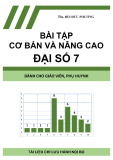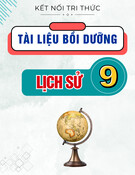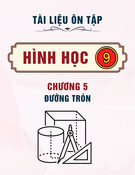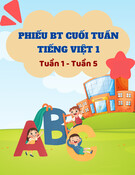
1
I. REVIEW
A. PHONETICS
Sounds: /a:/; /ʌ/; /s/; /z/; /b/; /p/; /ɪ/; /i:/; /t/; /d/; /s/ and /ʃ/
B. VOCABULARY
1. School things and activities
2. Verbs (play, do, have, study) + Noun
3. Types of houses
4. Rooms and furniture
5. Body parts and appearance
6. Personality adjectives
7. Places in a neighborhood
8. Things in nature
9. Travel items
10. Things and activities at Tet
C. GRAMMAR
1. Simple present tense
2. Adverbs of frequency
3. Possessive case
4. Prepositions of place
5. Giving suggestion
6. Present continuous tense
7. Comparative adjectives
8. Asking for and giving directions
9. Countable and uncountable nouns
10. Modal verb: must/ mustn’t
11. Should/ shouldn’t for advice
12. Some/ any for amount
a. Present simple tense and present continuous tense
Thì
Cách dùng
Dấu hiệu
Cấu trúc
SIMPLE
PRESENT
TENSE
(Hiện tại đơn)
1. Dùng để diễn tả
hành động lặp đi
lặp lại nhiều lần
như một thói quen
2. Dùng để diễn tả
lịch trình, thời gian
biểu.
- Adverbs of
frequency: Always,
usually, often,
sometimes,
seldom, rarely,
never (không bao
giờ)
(+) S + V / V+s/es…
(-) S + don’t / doesn’t+ V….
(?) Do/ Does + S + V…?
(H) WH + do/ does +S + V…?
- Chủ ngữ ở ngôi thứ 3 số ít như:
he, she, it, danh từ số ít (Tom,
her brother,…)
TRƯỜNG THCS PHƯỚC HƯNG
NHÓM TIẾNG ANH
ĐỀ CƯƠNG ÔN TẬP HỌC KÌ I
Môn: Tiếng Anh 6
Năm học 2021 – 2022

2
3. Dùng để diễn
đạt một sự thật
hiển nhiên
- Every (day, week,
year, Sunday,
summer...)
- On Mondays,
twice a year...
thêm “s” hoặc “es” vào sau động
từ.
- Chủ ngữ ở các ngôi còn lại như:
I, you, we, they, danh từ số
nhiều (my friends, Nhi and
Phong, ...) động từ giữ nguyên.
PRESENT
CONTINUOUS
TENSE
(Tương lai đơn)
- Dùng để diễn đạt
một hành động
đang xảy ra tại thời
điểm nói hoặc
xung quanh thời
điểm nói
- Diễn tả dự định,
kế hoạch
- now, right now, at
the moment, at
present, at this time
- Imperatives:
Look! Watch!/
Listen!/ Be
(careful/ quiet)!
- Answer questions
with “Where”
Eg: Where is your
mother?
She is cooking tin
the kitchen.
(+) S + am/ is/ are + V-ing
(- ) S + am/ is/ are + not + V-ing
(?) Am/ Is/ Are + S + V-ing…?
Yes, S + am/ is/ are.
No, S + am not/ isn’t/ aren’t
(H) WH + am/ is/ are + S + V-
ing…?
b. Possessive case (Sở hữu cách)
- Chúng ta sử dụng ’s sau một tên riêng.
Ví dụ: This is Elena’s room. (Đây là phòng của Elena.)
- Chúng ta sử dụng ’s sau một danh từ số ít.
Ví dụ: This is my mum’s book. (Đây là quyển sách của mẹ tôi.)
c. Prepositions of place (Giới từ chỉ nơi chốn)
- Giới từ chỉ nơi chốn mô tả người hoặc vật đang ở đâu.
+ in: trong
+ on: trên
+ behind: phía sau
+ under: bên dưới
+ next to: bên cạnh
+ in front of: phía trước
+ between: giữa
d. Giving direction
* Asking the way:
Khi hỏi đường, chúng ta có thể dùng các cấu trúc câu hỏi sau:
- How do I get to + …………………..?
- Can/ Could you tell/ show me the way to + ………………..?
- Do you know where the + ………………….. + is?
* Giving the way ( chỉ đường):
Khi chỉ đường chúng ta có thể dùng các câu và cụm từ sau:
- turn left/ right: rẽ trái/ phải.

3
- go straight: đi thẳng.
- go along: đi dọc theo.
- Take the first/ second turning on the left/ right: rẽ trái/ phải ở ngã rẽ thứ nhất/ hai.
- It’s on your left/ right: Nó ở bên tay trái/ phải của bạn.
e. Giving suggestion
Let’s + v!
What about + V-ing?
Shall we + V?
Eg: Let’s go to the movie!
Shall we go to the movie?
What about going to the movie?
f. Comparative adjectives (So sánh hơn của tính từ)
- Ta dùng so sánh hơn để so sánh 2 người, 2 vật với nhau.
* Short adj (tính từ ngắn):
- Tính từ ngắn: là tính từ chỉ có 1 âm tiết (big, small, wide, long, short, tall…) hoặc tính từ có 2 âm tiết
nhưng tận cùng là -y, -ow, -er, -et, -le (busy, noisy, narrow, clever, quiet, simple)
- So sánh hơn của tính từ ngắn:
be + short adj (tính từ ngắn) + ER (than)
E.g.
Tính từ ngắn
So sánh hơn
small (nhỏ) →
smaller (nhỏ hơn)
long (dài) →
longer (dài hơn)
- Nguyên tắc thêm đuôi -ER:
+ tận cùng là E, chỉ cần thêm R: wider, larger
+ nguyên âm đứng giữa 2 phụ âm, gấp đôi phụ âm cuối, rồi thêm ER: bigger, hotter
+ tận cùng là Y, trước Y là phụ âm, chuyển Y thành I rồi thêm ER: busier, happier, noisier
* Long adj (tính từ dài)
- Tính từ dài là tính từ có từ 2 âm tiết trở lên: modern, boring, beautiful, exciting, expensive…
- So sánh hơn của tính từ dài:
be + more + long adj (than)
E.g. modern (hiện đại) → more modern (hiện đại hơn)
* Một vài tính từ đặc biệt:
Với một số tính từ sau, dạng so sánh hơn của chúng không theo 2 quy tắc trên.
Tính từ
Dạng so sánh hơn
good (tốt) →
better (tốt hơn)
bad (tệ) →
worse (tệ hơn)
far (xa) →
farther/ further (xa hơn)
much/ many (nhiều) →
more (nhiều hơn)
little (ít) →
less (ít hơn)
old (già) →
older/ elder (già hơn, lớn tuổi hơn)

4
g. Countable nouns and uncountable nouns
- Danh từ đếm được là những danh từ có thể đếm trực tiếp số lượng người hay vật/ sự vật ấy bằng cách
sử dụng số đếm. 2 loại danh từ đếm được “số ít (singular) và số nhiều (plural)”
Eg: a pen → pens, a watch → watches,…
- Danh từ không đếm được là những thứ mà chúng ta không thể đếm được bằng số. những vật quá nhỏ,
vô hình (chất lỏng, bột, khí, tiền, thời gian, hạt, hột …..): cream, chocolate , water, rice, sugar, time,
money...
h. Modal verb: must/ mustn’t
Positive form
Negative form
Form
S + must + V
S+ mustn’t + V
Use
Diễn đạt sự cần thiết, bắt buộc ở hiện tại
hoặc tương lai
mustn’t (không được phép) có ý nghĩa chỉ sự cấm
đoán.
Example(s)
- I must pick up my mom at 5pm.
- You must be hungry after work hard.
- The boy musn't play baseball in that garden.
- You mustn’t walk on the grass.
i. Should/ shouldn’t for advice
Form
(+) S + should + V
(-) S + should + V
(?) Should + S + V ?
Yes, S + should.
No, S + shouldn't.
Eg: We should brush our teeth twice a day.
We shouldn't waste water.
→ “Should/ shouldn’t” dùng để diễn tả lời khuyên, hay ý nghĩ điều gì là đúng, nên làm hoặc không nên
làm.
j. a/ an/ some/ any
- an + danh từ đếm được số ít, bắt đầu bằng một nguyên âm (u,e,o,a,i)
Eg: an apple, an umbrella,…
- a + danh từ đếm được số ít, bắt đầu bằng một phụ âm
Eg: a pen, a school,…
Ngoại lệ: an hour, a uniform,…
- some + danh từ đếm được số nhiều/ danh từ không đếm được
“some” dùng trong câu khẳng định hoặc câu đề nghị, lời mời
Eg: I have some oranges
Would you like some water?
- any + danh từ đếm được số nhiều/ danh từ không đếm được
“any” dùng trong câu phủ định hoặc câu hỏi
Eg: There aren’t any milk in the bottle
Are there any bananas?

5
REVISION FOR THE FIRST EXAMINATION
GRADE 6 (2021 – 2022)
PART A: PHONETICS
Mark the letter A, B, C or D to indicate the word whose underlined part differs from the
other three in pronunciation.
1. A. big B. wide C. quiet D. exciting
2. A. mothers B. centers C. aunts D. cousins
3. A. cities B. watches C. dishes D. houses
4. A. cheap B. sleepy C. near D. peaceful
5. A. special B. spring C. she D. sugar
PART B: VOCABULARY AND GRAMMAR
Exercise 1: Mark the letter A, B, C or D to indicate the correct answer to each of the
following questions.
1. Green Hotel? Go to the end of the road. It's on your________ .
A. direction B. leg C. turn D. left
2. It’s going to rain, and I forget to bring a________.
A. coat B. hat C. umbrella D. torch
3. We ___________ the news at the moment.
A. watch B. is watching C. are watching D. watches
4. The first person to visit our home at Tet is the ________ .
A. newcomer B. first footer C. stranger D. neighbor
5. We use _______ to cut papers or something.
A. scissors B. valley C. plaster D. compass
6. You ________ your car in this area.
A. mustn’t park B. must parking C. mustn’t to park D. must to park
7. There are many famous paintings in this________ .
A. supermarket B. gallery C. memorial D. cathedral
8. _______ car is modern and expensive.
A. Jane B. Jane’s C. Janes’ D. Janes
9. I think your town is ________ than my town.
A. more new B. modern C. more ancient D. more older
10. Your neighborhood is________ my neighborhood.
A. quieter than B. more quiet C. more quietly D. more quieter
11. Could you please tell me the ________ to the post office?
A. road B. way C. street D. path
12. The city is always crowded and ________ . I don’t like it.
A. noisy B. quiet C. peaceful D. convenient


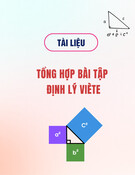


![Bài tập so sánh hơn và so sánh nhất của tính từ [kèm đáp án/mới nhất]](https://cdn.tailieu.vn/images/document/thumbnail/2025/20250808/nhatlinhluong27@gmail.com/135x160/77671754900604.jpg)
![Tài liệu tham khảo Tiếng Anh lớp 8 [mới nhất/hay nhất/chuẩn nhất]](https://cdn.tailieu.vn/images/document/thumbnail/2025/20250806/anhvan.knndl.htc@gmail.com/135x160/54311754535084.jpg)

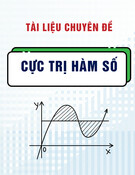
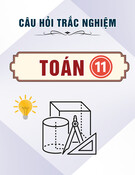
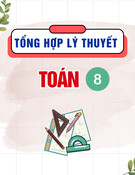
![Tài liệu Lý thuyết và Bài tập Tiếng Anh lớp 6 [Mới nhất]](https://cdn.tailieu.vn/images/document/thumbnail/2025/20250802/hoihoangdang@gmail.com/135x160/18041754292798.jpg)
